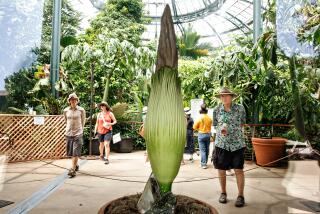GARDENING : Heralding a New Interest in Angel’s Trumpet
- Share via
Some folks think they’re heavenly. Others regard them as hellish. The fragrance can entrance you, but the plant can kill you if you’re foolish enough to consume its seeds or leaves.
Despite the shortcomings, brugmansia, popularly known as angel’s trumpet, and its close relative, datura, are undergoing a popularity revival because the fragrance is so alluring and the flower divine looking.
These fast-growing shrubs in the nightshade family produce very large, pendulous single or double flowers in hues of white, yellow, orange or variations thereof, that produce hypnotic fragrances at night. The plants also contain hallucinogenic properties, deadly poisonous seeds and deservedly have the reputation of being killers, like their other relatives in the Solanum family (such as jimson weed).
The names brugmansia and datura have been used interchangeably, but recently botanists reclassified them.
“For most purposes, if the flowers hang down, the plant is a brugmansia. If the flower is upright, it’s a datura,” explained John Lenanton, professor of botany at Orange Coast College in Costa Mesa.
Despite the confusion over name and toxicity, gardeners are increasingly adding them to their landscapes.
“People are a little afraid of the plants because they are so poisonous, but we’ve doubled our sales in just the past two years,” said Evelyn Weidner, owner of Weidner’s Gardens in Encinitas. Weidner’s is both a retail facility and a wholesale grower, supplying plants to many nurseries throughout Orange County. When she planted several brugmansias in her display garden, the sales of this exotic plant rocketed as people were captivated by both the large flowers and heady fragrance.
“I always caution people to think very carefully about planting brugmansias if they have small children or pets, but I also find the plants don’t easily shed their seeds,” she added.
Weidner offers four varieties, with flowers of either white, pink, frosty pink or a tricolor with flowers that change hues from white to soft yellow to apricot pink.
Weidner is also growing a variety of datura that hasn’t been available to the public. Datura metallica is gaining a lot of attention with its showy purple flowers with white interior. Although not fragrant, the purple datura is a striking plant that flowers heavily from summer through winter. The plant is more contained than brugmansia, with pronounced upright growth instead of sprawling.
Once established, brugmansia is almost indestructible and is a rampant grower that can reach up to 20 feet with a spread of eight to 10 inches. It can be kept smaller by constant pruning, although experts advise pruning when all danger of frost is over so the wood isn’t exposed to cold.
“It’s a big, bold plant, but not a pretty one and is best when placed at the back of the garden,” advised Dale Kolaczkowski, manager of Stallings Exotic Nursery in Encinitas. Stallings specializes in tropical and rare plants and offers 10 different brugmansia varieties, all grown from cuttings at the nursery. The nursery also sells by mail-order.
But Wade Roberts, director of Sherman Gardens in Corona del Mar, which has a display of five different varieties, disagrees.
“I think it’s a gorgeous sight to see the plant loaded with flowers,” he said. “They flower almost nonstop in our coastal climate. And as many years as I’ve walked past them, I still am overwhelmed each time I smell the fragrance. They still bowl me over.”
But the plants don’t automatically flourish.
Until they’re established, both brugmansias and daturas are temperamental plants.
“They remind me of Republicans; they don’t like change,” said Kolaczkowski wryly.
The problem is that the plants are prone to dropping their leaves and flowers with temperature fluctuations such as cold snaps or Santa Ana conditions. Despite a straggly, sickly appearance, the plant usually survives and re-blooms. They also drop their leaves each winter.
“They’re native to the Andes, and they prefer the cool climate at their native altitude of 4,000 to 5,000 feet,” Kolaczkowski explained.
When they’re planted in conditions they like, they thrive in Orange County.
Along the coast, they can be planted in full sun and are almost indestructible.
Inland, they should be planted where they receive afternoon shade so they can cool down as they would in their native Andes mountains. Inland, they appreciate a daily misting in late afternoon. The plants are also susceptible to frost.
*
Insects find the plants very attractive--they love to feast on the narcotic leaves and flowers.
This is another reason Kolaczkowski recommends placing them in the background, so the insect damage isn’t as noticeable.
“After five years or so, the plants build up enough toxicity that the insects die and the plants are then defended from further attacks,” he said.
Gardeners can spray against the insect invasion with chemicals or blasts of water or choose to ignore them, because insects won’t kill the plants. Kolaczkowski recommends the latter approach, although Weidner reports good results using fertilizers containing systemic insecticides.
Brugmansias also like moist soil conditions, but overwatering can make them susceptible to attacks by soil fungi.
Gardeners can choose to fertilize them or not, depending on time and effort they want to spend. Kolaczkowski says that since they grow so rapidly, they don’t need fertilizer, but Weidner reports good results with occasional feeding to encourage deep green leaf color.
Many nurseries are now stocked with Brugmansias. Look for the daturas closer to summer, when they bloom.
The plants can also be ordered if not in stock.
Resources
* Stallings Exotic Nursery: 910 Encinitas Blvd., Encinitas, Calif. 92024, (619) 753-3079
* Weidner’s Gardens: 695 Normandy Road, Encinitas, Calif. 92024, (619) 436-2194






